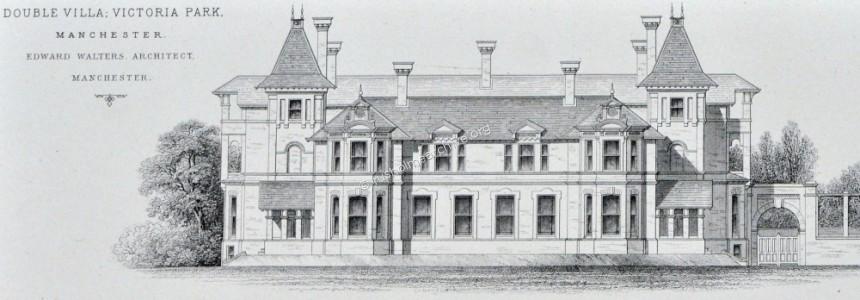Rusholme & Victoria Park Archive

The object and purpose of the Institution shall be the reception and reformation of penitent women who have led unchaste lives, with, a view to their restoration to a proper mode of life.
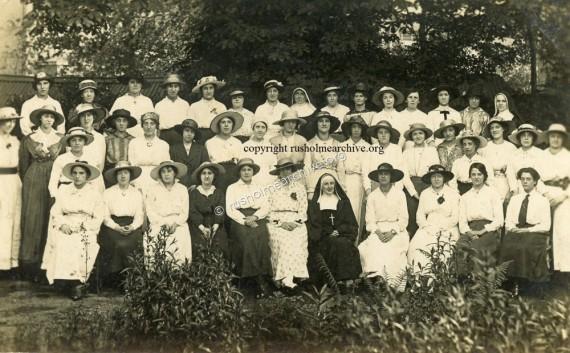
The annual meeting of St. Mary’s Home (a penitentiary), West Gorton, was held in the Mayor’s Parlour at the Manchester Town Hall, March 1st, 1871. Printed below are comments made by the Mayor and Bishop of Manchester that were reported in the Manchester Guardian.
"The poor creatures who were fortunate enough to gain admission were received with a gentle sympathy which helped them to forget their humiliation. They were entrusted with various kinds of household work; they helped in some measure to support the Home and prepared themselves for a return to honest and goodly lives."
“Honest work was a powerful counteractive against the vices of pride, sloth and lust, and therefore the committee were acting rightly in making healthy work of an industrial work, and he hoped if not of a too onerous nature, it was an essential feature in their arrangements for the treatment of the young women committed to their charge.”
"With reference to the evil of prostitution, he had no idea of the extent to which it prevailed in Manchester. The Mayor, although he had not the figures at hand, told him that there must be thousands of prostitutes in this city and in Salford. Figures of that kind were, of course, apt to range rather widely; but facts which had come under his own observation made him literally shudder at the phenomena by which they were surrounded."
"The style of women’s dress in the highest ranks was not becoming to woman’s modesty, (applause), and the literature wliich they read was not likely to implant in them principles of purity. The papers, for instance, which lay upon some drawing-room tables, containing the horrible records of the Divorce Court, which were open to perusal by all the members of the family, were a disgrace to our Christianity and our civilisation.— (Hear, hear). There was a gross neglect of duty on the part of the masters and mistresses of households towards their domestic servants".

St Mary's Home was a large institutional building constructed in 1871 that stood on the northerly side of Dickenson Rd, mid-way between Wilmslow Road and Anson Road it, was demolished over half a century ago sometime in the early 1960’s.
Some years ago, I compiled brief notes about St Mary’s Home for Penitent Women, 77 Dickenson Road, Rusholme. What prompted me to return to this story was finding the photograph shown at the top of this page. I had been searching for photographs by Frank Wyles whose ‘Birch Studio’ is featured on another page about Rusholme photographers.
Frank Wyles moved to 124 Dickenson Road where he opened his photographic studio in 1908 which was almost opposite St Mary’s Home, (see the map below) with the two premises outlined in red.
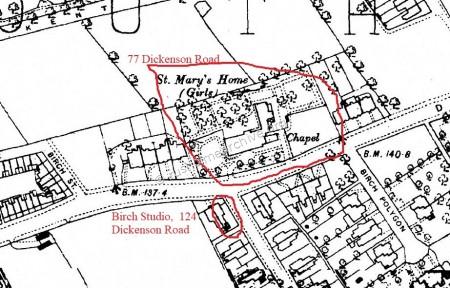
I had never thought it would be likely to come across any photographs of St Marys home or the residents; I hardly think that there might be any circumstances in which photographic memories of being a resident would have been treasured like other family photographs. The photograph above by Frank Wyles could only have been taken at the request of the Nuns who managed the home, was it taken for their records? Although the postcard is undated it has been suggested that the dress worn by the women is circa 1910.
Trying to confirm my view that this photograph was taken at St Mary’s you need to examine the photograph closely. Clearly there are three nuns, with perhaps the Mother superior in the centre of the back row, and there are several other (older?) women dressed more carefully. There were lay staff employed in the Home, a ‘House Steward’ responsible for day to day management, a laundry Matron, and a needlework Matron. Perhaps there are also women in the photograph who were ‘Local Worthies’, offering much needed financial and moral support for the work of the home?
Very obviously the rest of the women are plainly dressed, perhaps almost in a uniform style with a white blouse. However, amongst this group the most significant feature is the absence of any smiles, indeed some understandably(?) look morose, if not scowling. Look at a close-up of the group below, I am sure that any gathering of women in a group photograph would have smiled.
My confidence that this photograph is of the residents and inmates of St Mary’s Home has now been confirmed after correspondence with Sisters at St Peters Convent, Horbury. They told me that Mother Gertrude is the Sister standing at the centre, back row.
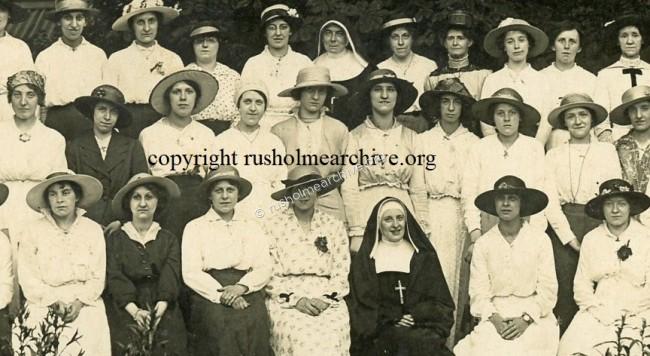
Whether or not you accept this photograph is of the residents, you are welcome to read my research about the background and history of St Mary’s Home. To begin with you might be curious as to the name and use of the word Penitent Women. When I first started searching for information about St. Mary’s I found reference to the home on a genealogical forum. A descendant of an inmate posted the following query.
Hi Everyone,
I am trying to find out what type of institution St. Marys House, Rusholme was. In the 1891 census there were a large number of females there all of whom are described as inmates.
Was this a prison or some kind of hospital?
There was brief reply from another user.
‘Hi,
Slater's Manchester & Salford Directory, 1895. [Trades, Institutions, Streets]
Page: 322
Charitable Institution
St Mary's Home
Conducted by the Sisters of the Community of St Peter the Apostle Horbury. 77 Dickenson Rd, Rusholme.
Hope it helps’
‘Thanks for that.
Does anyone have any idea what type of Charitable Institution this place would be? The female that I am researching was 21 in 1891 & Rusholme is about 35 miles from where her family were living. Why would someone of such an age be living in a 'Charitable Institution' run by Nuns & at such a distance from her family?’
‘Found this information re St Mary's Home.
Publication: 'A History of the County of Lancashire" Vol: 4
Year: 1911
St Mary's Home for Fallen Women, Rusholme’
‘Hi,
Thanks again for that. Now that I know that things are making a bit more sense. The woman that I'm researching is my Gt. G. Mother & I already knew that she had 2 dodgy pregnancies but what doesn't seem to make sense is that she was still in there in 1891 when her age was given as 21yrs. So even in Victorian times she would have been considered to be of 'full age' & surely would be free to leave such an establishment of her own accord. Unless the authorities could force her to stay in there for giving birth to 2 bastard children who would then obviously have become a burden on the Parish.
I need to investigate a bit further to try to get to the bottom of it I think.’
You might now, (understandably), be seeking a clear explanation of the work of St. Mary’s Home for Penitent Women. The stories of ‘Fallen Women’ filled many newspaper columns in the Victorian period and there are several publications that explore the circumstances of women who had ‘Fallen’.
In 1996 Dr Susan Mumm, whilst at the Open University wrote a paper; ‘Not worse than other girls.’
The second paragraph of her paper very succinctly explains the role of the ‘Female Penitentiary’.
“In Victorian Britain, a female penitentiary was not a penal institution for the punishment of crime, but a charitable enterprise entered voluntarily by members of an outcast group, popularly known as 'fallen women.' Many fallen women were prostitutes, but the category also encompassed groups other than sexual deviants: female thieves, tramps, alcoholics, and those who were described as feeble-minded were also considered fallen, and it was seen as appropriate to rehabilitate them alongside streetwalkers. Penitentiaries were intended as transformative institutions, where female outcasts of many kinds could be changed into 'honest' women, a conversion which incorporated both a spiritual change from sinner to penitent, and an equally important social shift from dissolute and deviant female to respectable woman. The penitentiary, despite its penal overtones, was a therapeutic community which was not experienced as unbearably punitive. As well as reforming prostitutes, Anglican penitentiaries in Victorian Britain offered shelter to the survivors of incest and sexual violence, women fleeing abusive relationships, and female alcoholics.”
(Mumm, Susan (1996). ‘Not worse than other girls’: the convent-based rehabilitation of fallen women in Victorian Britain. Journal of Social History, 29(3) pp. 527–547).
I would like to take this opportunity of expressing my appreciation to Dr Mumm for giving me permission to quote from her paper. I certainly would suggest that you take the opportunity to read this paper
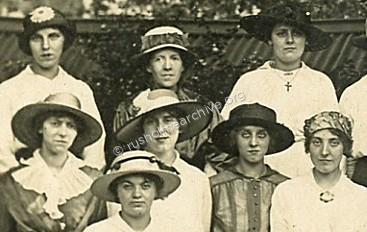
Researching information of St Mary’s Home, I initially read the reports of the Annual Meetings that were published in the Manchester local press, primarily the Manchester Guardian and the Manchester Courier. There was also a modest reference to St Mary’s in “The Call of the Cloister” by Peter Anson, formerly an Anglican Benedictine monk.
The formal records of the Home were Minutes kept by the Executive Committee of St Mary’s Home. The minutes covered the period from 1864 to 1945, however, minutes during the period 1877 to 1900 are missing. Reading these minutes was not particularly informative, they were not very detailed and rarely reported individual contributions. The minutes are part of the Manchester Diocese records but have been transferred to the Manchester Central Library Archives (with access only to minutes that are over 100 years old). Through the good offices of the Central Library Archivist I am hoping that permission will be granted by the Diocese to see the minutes from 1939-1945. I hope that these minutes may reveal some of the problems that the Trustees faced prior to the closure of St Mary’s in 1945. Additionally, I have also used genealogical websites to find Census records and also searched the National Newspaper archive etc.
St Mary’s Home was established in 1864 with the encouragement and assistance of the Church Penitentiary Association.
The CPA can trace its roots back to 1806 when the original church penitentiary for the reclamation of fallen women was founded in London; later in 1848 the most well-known centre was set up by former British prime minister William Ewart Gladstone.
The image below has been taken from the first page of the Minute Book of the Management Committee of St Mary’s Home. The meeting was held at the Rectory of St Philip’s, Hulme on Monday October 24th, 1864*. The first name of those attending was Rev. George Anson of St James, Birch-in-Rusholme, he was to be the Chairman of the Committee for some 30 years. The second name is Rev. Robert Birley, Rector of Hulme who also served for many years as the secretary of the committee.
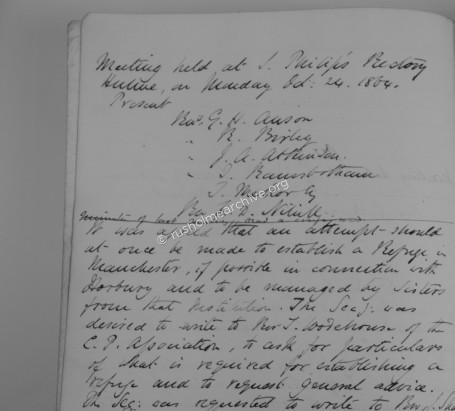
Image above courtesy of Manchester Archives; M629/3/5
The minute records that: ‘It was agreed that an attempt should at once be made to establish a Refuge in Manchester, if possible, in connection with Horbury and to be managed by Sisters from that Institution. The Secretary was desired to write to Rev. Wodehouse of the C.P. Association, to ask for particulars of what is required for establishing a Refuge and to request general advice.
(I do not pretend to be a scholar of the Tractarians, a movement of Anglican High Church members that during the mid 19th century developed into Anglo-Catholicism. It is evident from this founding minute that Rev. Anson, (whose father-in-law was Dr Hook, a noted Tractarian), was seeking advice and help from the Sisters at Horbury, a Covent that been founded by Tractarians. Later in the life of St Mary’s, an Anglo-Catholic church at nearby Ardwick, St Benedict, played a notable part in the role of St Mary’s Home as ‘Father’ Gethen of St Benedict’s became the chaplain of St Mary’s Home. I think that this aspect of Anglo-Catholicism was a pattern that was apparent in other Sisterhoods that managed similar Houses of Mercy.)
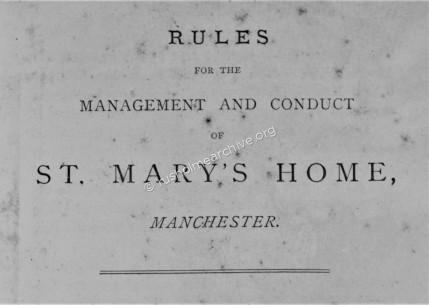

Images above courtesy of Manchester Archives:M629/3/5
The first location of the home in Manchester was opened in 1865 on Hyde Road, Gorton. I believe the property was comparatively small and could only accommodate 10-12 inmates. Although the advertisement below refers to ‘Ladies’ helping at the home discipline and spiritual life would have been managed by Anglican nuns. The Manchester Courier displayed the following notice April 7th1866.
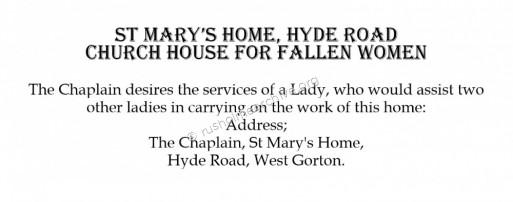
In October 1870 there was a minute recorded by the Executive Committee giving an instruction that supplies should, wherever possible, be purchased from the Civil Service Supply Association. This seemed to me be a strange request; the Civil Service Supply Association was a Cooperative on The Strand in London, I cannot find any evidence that there was a branch in Manchester and to order goods from London would have incurred expensive shipping costs(?). However, a photograph of Wilmslow Road, (below, looking north), does show a shopfront with the name of the Civil Service Provision Co., located on the corner of Walmer Street, perhaps this was the business referred to?
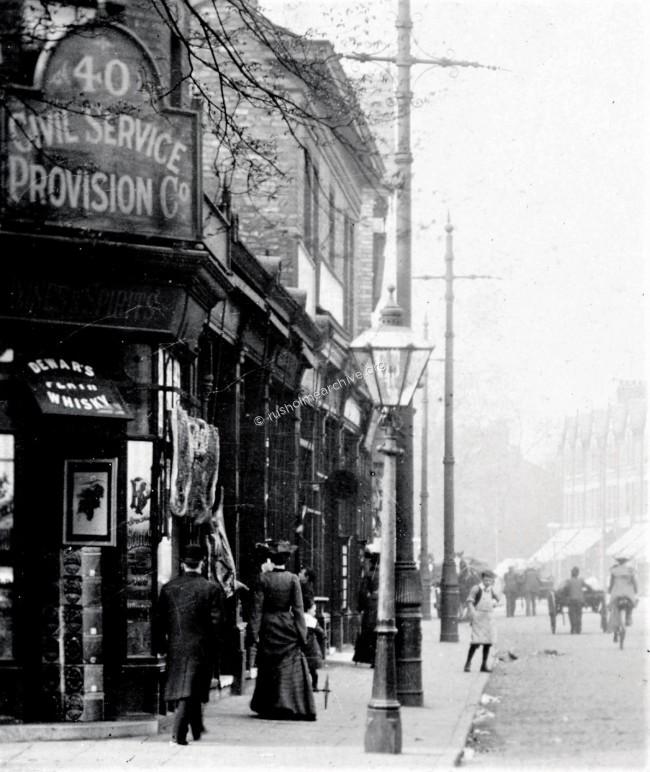
In March 1871 the Manchester Courier reported the proceedings of the St Mary’s Home AGM held at Manchester Town Hall, the Mayor in the Chair.
The Hon. Secretary (the Rev. R. Birley) read the report, which the Committee said they presented with thankfulness and hope. Each year they had been concerned that so large a number of those who might have been rescued from a life of sin should have been turned away owing to the insufficiency of accommodation at the Home.
The importance of providing a more suitable building had engaged their attention, and eight months ago they purchased a very desirable site in the parish of St. James, Birch, at a cost of £1,663.
They had since endeavoured to raise funds for the building. Money had come in but slowly. Nearly £2,000, however, had been paid or promised; and they had decided to proceed without delay, in the hope that the public would support them in their efforts to complete the undertaking. A further sum of £1,000 would be required. In January 1870, there were 13 inmates in the Home, and during the year nine more were admitted. Of this number, two had been sent back to their friends; two remained only a few days; three were transferred to other penitentiaries; one died in the workhouse; and 14 were now in the Home. During the year 29 were rejected for want of room. The treasurer’s statement showed a balance against the institution of £18. The building fund account was as follows: Cash received, £3,107; paid for land, £1,663; balance remaining, £1,444.
During his speech the Mayor made the following remarks,
'Until good and virtuous women could be brought to look candidly and forgivingly upon them no great progress would be made in the reclamation of their fallen sisters. The penalties suffered by a poor girl who broke the laws of her sex were cruelly and unjustly severe; but more cruel still they were imposed upon her chiefly by women. It was not so much the fear of encountering her brothers as that of encountering her sisters which prevented many a penitent girl who had strayed from returning to her home. That unchastity should be held in abhorrence was proper enough; yet it could not be right to pursue a fellow-creature with relentlessness and make no effort to awaken in her new aspirations after a better life, or to shrink from her as if she was forever plague-stricken. It was the habit at present for ladies to ignore entirely this great curse of their sex, — to avoid their fallen fellow-women altogether, and thus to harden them in their vices by rendering their isolation complete and restoration impossible.'
The Bishop of Manchester in moving the adoption of the report said,
‘The Mayor had classed St. Mary’s Home among the obscure charities of this city. Necessarily from its very nature its work must to a certain extent be veiled. It could not be flaunted in the eyes of the philanthropic public to the same extent as other philanthropic objects were. But, though the work was obscure in the sense of its being done in simple faith and love on behalf of a class of sufferers to whom society was more than usually unkind, he would venture to say that no work was done in Manchester which stood out brighter before the angels of God or before Him who sat upon the throne". (Applause.)
The committee minutes of the Trustees which refer to the purchase of a site for a new home were, I suspect, somewhat understated.
When the committee was told of the ‘desirable site’ on Dickenson Road there was, according to the minutes, a very strong objection. This was followed by an ‘animated discussion’. At the following meeting it became clear that the site, (including Birch Cottage) had previously been the home of the *Rev George Anson, which together the adjoining plot belonged to Sir John Anson Bart., (the older brother of George Anson).
Sir John wanted £1,800.00 and the trustees offered £1500.00 for the site; Sir John was prepared to ‘split the difference’ provided that a covenant was agreed that there could be no further development on the site where a rental valuation was less that £40.00 per annum. This proviso was similar to the building ‘tie’ in Victoria Park, where, in effect, no small properties could be built. The amount of money paid for the site was a very high price for prime residential homes. The £1683.00 finally agreed was virtually a million pounds at present day values; Look at the table beneath that has been taken from the ‘Measuring Worth’ website.
To compare the value of a £1,683 0s 0d in 1871 there are four choices.
In 2018 the relative:
real wage or real wealth value of that income or wealth is £153,900.00
labour earnings of that income or wealth is £962,100.00
relative income value of that income or wealth is £1,268,000.00
relative output value of that income or wealth is £3,062,000.00
*Whatever the questionable circumstances regarding the acquisition of the site, Rev. Anson, (photograph below), did make a significant contribution to the management of St Mary’s Home. After his death in Feb.1898 the Manchester Guardian obituary referred to the Archdeacon Anson,
‘Outside his church, the institution to which he was most closely attached—he was really its founder, and he acted as its honorary chaplain from its origin—was the admirably conducted St. Mary’s Home, in Dickenson Road, Rusholme’.
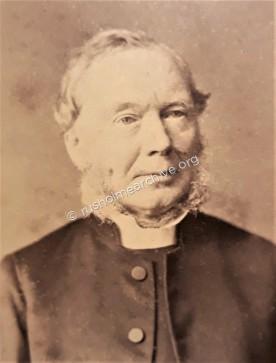
Later that year, 1871, May 1st the Manchester Courier reported,
‘That in the presence of a large company the Bishop of Manchester laid the foundation stone of St Mary’s Home. The institution has been established in connection with the Church of England as a refuge for fallen women who are penitent and are desirous of reforming their character.
The plan of the building is oblong, placed broadside on to the public road. The front portion is to be set apart for the accommodation of those who manage the home, and the back portion is devoted to the inmates, also to the cooking and washing departments. Special attention has been paid to the ventilation of every room; and the elevations, although plain, are well proportioned. The chapel will project from the east end, and will be lighted, not only by windows at both sides, but also by a triplet at the east end.’
I thought it was worth emphasising in bold letters the reference to the ventilation of rooms; Was there a perception that if the penitent women were to be lying in a warm and cosy bed this might encourage lascivious thoughts……
The Bishop said the occasion was one of special interest to them all.
'So far as he knew this was the first attempt the wealthy, well-to-do clergy of England had made in this vast city to deal with the great problem of how to raise the fallen, and, if possible, restore them at least to a condition of respectability. Without ignoring or wishing in the least to depreciate what had been done through other agencies, he did feel most distinctly that it was time the Church of England, if she was to "be true to her mission, should undertake this work on her own principles and in her own way. — (Hear, hear.) He therefore rejoiced that they had met together to lay the foundation stone of what was well called a house of mercy, a house which he trusted might be a home in the years to come for many a broken and contrite heart whom Satan had for a while led captive and dealt with almost at his will.'
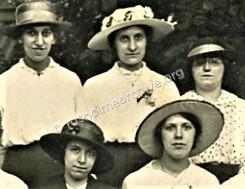
For a comprehensive description of the property I found two references about the construction under two dates in a 1871 edition of ‘The Builder’. Much of the text in the two items was repetitive so I have edited the description.
ST. MARY’S HOME, RUSHOLME.
The plan of the building is an oblong, and its broadest side will face Dickenson Road. The front portion of the building will be set apart for the persons managing the home, and the back part will be used by the inmates. The workroom and dining room for the inmates are each 16 ft. 6 in. by 16ft., and the ceilings throughout are 11ft. The washhouse, which is 19ft. by 15 ft., and the laundry, which is 24ft. by 15ft., project at right angles to the back portion of the building, while beyond are various other buildings. Adjoining the laundry is a drying stove, while the washhouse will be fitted up with all the latest improvements. A covered way forms a means of communication between these outbuildings and the main building. A corridor runs from end to end of the main building, forming a means of ventilation. The staircase and entrance hall are nearly in the centre of the front part of the building, having the committee-room and waiting room on one side, and the ladies’ dining and sitting rooms on the other. The superintending ladies’ rooms are to the front of the building, on the chamber floor, while at the back are dormitories for the inmates, 49ft. 6in. by 21ft. 3in., and 28 ft. 4in. by 21 ft. 3 in. respectively. The dormitories for the inmates are separately arranged and two in number, one containing eighteen beds and the other ten. They are lofty, well lighted and ventilated, and the larger one is provided with two large stoves and the smaller one with one stove.
The chapel projects from the east end of the building and is lighted by windows on both sides and by a triplet at the east end, with a chaplain's room adjoining. Several of the windows of the chapel have been filled in with stained glass, while the aisles and altar space have been laid with encaustic tiles. The glass has been done by Messrs. Livers, Barraud, & Westlake, of London and Manchester, and represent the Crucifixion (in the triplet east window), and SS. James and Andrew, the Good Shepherd, and the " Noli me tangere." The staircase window, which forms the central feature in the front elevation, is also filled in with stained glass, arranged in geometrical patterns, and the gable over it is terminated with a wrought-iron terminal.
The building is provided with bathrooms and other conveniences, and attention has been paid to ventilation. The elevations are plain, and are executed in selected common bricks, with white headers, relieved by bands and arches of stock bricks. The entrance and staircase hall form the principal features in the front, and the doors and windows have stone dressings. The roofs are covered with slates of two tints and are finished with red ridge tiles. The total cost of the buildings and boundary walls is about £3,000.
The building is being erected from the designs of Mr John Lowe, architect, by Mr. George Napier, builder, Hulme.
The references to the laundry indicate that a very essential part of the income of the home was from providing a laundry service in the locality, together with needlework repairs etc.
Working in the laundry was considered an essential part of reforming the character of the fallen women, there was view held by some that working with so much water might help to wash away some of their sins!
In one of the subsequent annual reports, the question of the amount of hard work undertaken by the penitents was raised. The reply was predictably uncompromising.
‘Honest work was a powerful counteractive against the vices of pride, sloth and lust, and therefore the committee were acting rightly in making healthy work of an industrial work, and he hoped if not of a too onerous nature, an essential feature in their arrangements for the treatment of the young women committed to their charge’.
Illustration below is of St Marys Home, 77 Dickenson Road, Rusholme. Erected 1871 it was demolished circa 1961-65(?)
(Illustration reproduced by kind permission of Chetham’s Library)
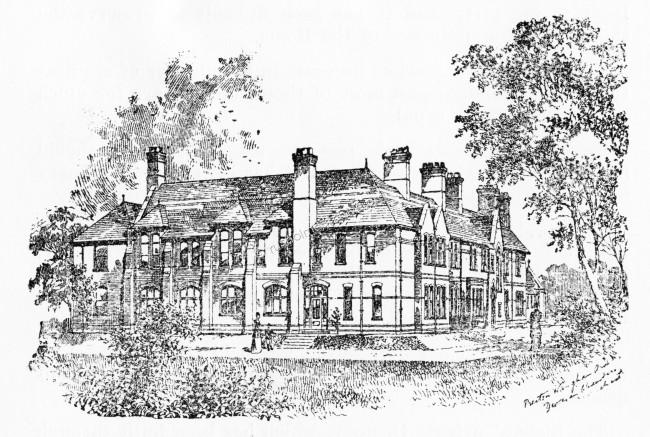
In the two or three years that followed the opening of the home it was inevitable that the annual meetings would concentrate on the costs associated with the establishing and maintaining the home.
11th March 1872. ST. MARY'S HOME.
The annual meeting of the subscribers to this institution was held to-day, at noon, at the Town Hall. The Bishop of Manchester presided, and there was a numerous attendance. The Rev. R. Birley read the annual report. It described the opening of the new home in Dickenson Road, Rusholme. During the past year there had been 23 inmates, of whom one had been sent temporarily to the hospital, one to the House of Mercy, Horbury ; three had relapsed, two had gone back to their parents, one was working in a factory, and fifteen were in the Home. The committee ventured to remind the public that the fact of their receiving double the number they had hitherto accommodated, would involve a very considerable increase in expenditure They must, therefore, appeal for fresh annual subscriptions, and for more offertories in churches. The outlay for the site of the new home was £1,660; and the building expenses, with laying out of the grounds, boundary walls and furnishing, would amount to not less than £3,800. *Of this nearly £3,700 had been either paid away or was in the bank, leaving a deficit of fully £100.
The Rev. Canon Crane moved the adoption of the report, which was seconded by Mr. T. Mellor, and agreed to. The Ven. Archdeacon Anson moved:
"This meeting is of opinion that the work of rescuing the fallen, as carried on at St. Mary's Home and other penitentiaries, is deserving of the hearty approval and support of all Christian men and women ; and that 'an appeal be made for fresh annual subscriptions and collections to meet the increasing expenditure."
The Rev. R. Tomlins, chaplain of the City Gaol, seconded the resolution, and it was adopted. The Rev. W. Doyle moved a vote of thanks to certain office bearers of the institution, and the appointment of a committee for the ensuing year. Dr R. Martin seconded the motion, and it was also passed. After a few remarks from the Bishop, the meeting was closed with the benediction.
*The cost of building the home was quite substantial; using the website ‘Measuring Worth’ the cost of £5460.00 brought up to 2018 values are in the table below.
In 2018, the relative wage or income worth of £5460 0s 0d from 1871 is:
£3,120,000.00 using the average earnings
£4,110,000.00 using the per capita GDP
£9,930,000.00 using the GDP
For more detailed information regarding this table click here
1873 Annual Meeting.
The annual meeting of the supporters of this institution was held this day, in the Mayor’s Parlour, Town Hall. The Bishop of Manchester presided.
The Ven. Archdeacon Anson read the annual report, which stated that, the cost of the new building erected for the purposes of the Home in Dickenson-road, Rusholme, was all paid. There were at present in the Home 22 penitents. There had been admitted during the year 32, of whom some had entered it apparently without any intention of remaining and had left again. During the year five inmates had gone to service, two had been restored to their friends, and four were now ready to go out to service. The annual statement of accounts showed a balance in favour of the institution at the end of the year of £51, and they also showed an increase in the amount received for the work done by the inmates, the amount being £11 in 1871. and £131 in 1872.
The Chairman said, ‘The subject on which they were met was one in which all must feel a profound interest, but it was also one on which it was very difficult to speak with the necessary frankness, and, at the same time, a proper reticence in a mixed audience of ladies and gentlemen such as he had before him. If we were to accept the dicta of those who would teach us in those days, we should accept prostitution as a social necessity. He confessed that it seemed to him that we could not accept that theory without being utterly false, not only to Christianity as a religion given to us to bridle our appetites and even our thoughts, but to those higher instincts of the natural man quite apart from any special revelation, which must make us feel that one sex was not to be ruined for the gratification of the lusts of another.’
On the motion of the Dean of Manchester (the Very Rev. B M. Cowie) seconded by Mr. R. M. Redhead, the report and statement of accounts were adopted. The Rev. J. F. Pitcairn moved a resolution urging the importance of procuring suitable situations for those penitents who were prepared for them. Mr. J. A. Bremner seconded the resolution and said the police returns showed a decrease of late years in the number of fallen women brought before the magistrates. In the year 1889 the number was 2,456, in 1870 it was 1,922, in 1871 it was 1,795, and in 1872 it was 1,025.
The resolution was supported by the Ven. Archdeacon Anson and passed; and after some formal business had been disposed of the meeting closed.
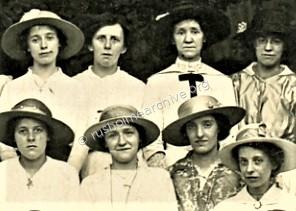
It is not my intention to report every Annual Meeting of St Mary’s Home, but in the 1874 report I found the following items of interest;
(1) Reference to the income raised from the inmates working in the laundry was £390.00.
The Rev Canon Birley referred to the amount received for needlework and washing. ‘In 1871, at the old house in Hyde Road, the amount altogether was £41; in 1872, the first year of the present home, £131; and in 1873, £445. Of that sum, £390 was received for washing. The total amount received showed an increase of £313.
‘These figures sufficiently attested the energy and care which had been exercised by the ladies of the house in maintaining the industrial character of the employment of the inmates. The chaplain reported his continued confidence in the good effect which the religious teachings and moral training produced in the character of the penitents’.
Looking at the figure of £390.00 for laundry income you may wonder how this sum relates to present-day values. Again, the excellent website ‘Measuring Worth’ has a variety of values which translate £390.0 to 2017, the table is below.

(2) The second item that I thought useful considering was a legacy to St Mary’s Home;
‘The Committee had to record the munificent bequest of £1,000 by the late Miss Brackenbury, which sum had been invested in railway debentures.’
Whether or not the investment in railway debentures proved a success certainly £1000.00 must have been a significant windfall. Hannah Brackenbury lived in Sussex and when she died in 1873 her estate was valued at £160,000.00. Reports in the press referred to her being a ‘Manchester lady’. During her lifetime she had made donations to the value of £100,000.00, beneficiaries including Owens College, (later Manchester University) and Manchester Grammar School. In her will she left bequests to Manchester institutions and notably, ‘to the Asylum for Female Penitents (Greenhays), and the new Asylum for Penitents (near Victoria Park)’.
Once again, I have called upon ‘Measuring Worth to illustrate the value of a £1000.00 bequest in 1873, the result is in the table below.

The Rev Canon Birley referred also to the number of the inmates, there were 22 at the present time in that house, and two more were expected shortly. During the year 29 had been admitted; six had gone to other business, eight had returned to friends, four had gone to service, and seven had left of their own accord, or had been discharged.
The question of ensuring that the Home had sufficient inmates had been a matter of discussion at the Executive Committee meeting in January 1874. It was decided to open communications with the various workhouses in the Manchester district as it was felt there might be suitable applicants who would benefit from coming to St Mary’s.
It was resolved, ‘That little cards and handbills with a woodcut illustration of the Home be circulated setting forth the advantages by becoming an inmate’.
Whether women in workhouse thought two or more years at the home would be preferable than as a resident in the workhouse has to be a matter of speculation but there was no further reference to the proposal in subsequent committee minutes.
The 1881 Census recorded 5 Sisters of Mercy, 2 Servants and 24 women ‘Training for Servant’, 23 of the women who were penitents were between the 15 and 21, whilst one was 31 years.
The 1889 Annual Report drew attention to Sister Vaux, the Lady Superior. She had started work in St Mary’s Home in 1865 when it had first opened in Hyde Road, Gorton, but now was giving notice of her resignation.
The Manchester Courier reported,
‘The Lady Superior had placed her resignation in the hands of the committee. She had superintended the home with energy and devotion beyond all praise for 24 years. The committee passed a resolution expressing appreciation of her long service and regret at her at her resignation. As to the future management of the home, a sub-committee which was appointed to deal with the matter recommended, subject to the approval of the bishop of the diocese, an arrangement made for the sisterhood at Horbury to take charge of the home. The bishop had now given his sanction to the scheme, and the authorities of the Horbury House of Mercy were willing to concur in the arrangement, and it would be carried out some few months hence.’
Horbury, near Wakefield in Yorkshire had been the home of the Community of St Peter the Apostle, established in 1858 it been helping to run ‘Penitentiaries’ in conjunction with the Church Penitentiary Association. Horbury had been founded with a clear mission.
"For the reception and protection of women who had led unchaste lives, with a view to their reformation, either in some reputable calling by which to earn a livelihood, or otherwise."
There is a detailed history of Horbury, (Horburyhistory.org) that can be read here
In the 1890 Annual Report the new arrangements for staff were confirmed.
“Miss Vaux, for 24 years Lady Superior of the Home had resigned, and her place been taken by Sister Gertrude, of the House of Mercy, Horbury. The staff now consists of three sisters, four helpers, two of the latter, like the Sisters, being voluntary workers. There were 22 people in the home at the beginning of the year; admitted since, 28; sent to service, nine; sent to other homes, three, sent to parents or friends, 11; left of their own accord, seven. The Medical Officer of Health strongly recommended the erection of a small sanatorium, at a cost of £150, but the straitened circumstances of the committee forbade them increasing the expenditure at present.”
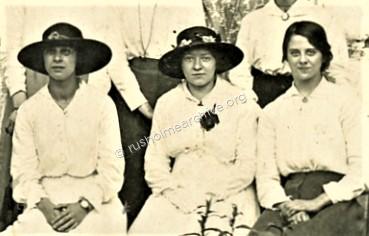
At this point I think that rather continuing with ‘Annual Reports’ it is worth looking again at the background of the work of St Marys Home.
Whilst in the Annual Reports there are mentions of prostitution, I think this may refer to many young women, who, having ‘fallen’, are at risk of perhaps being on a slippery slope to becoming prostitutes. I can well imagine that if a young woman found herself pregnant it might be better seeking admission to the home where with a combination of care, discipline and work, they would realise the time spent in the penitentiary would eventually be of benefit. The only possible alternative might have been the Workhouse, not only a very hostile atmosphere but where birth rates measuring mortality were as high as 90%.
It is important to be aware that there does not seem to have been any surviving records kept at St Mary’s regarding the background and status of the inmates. However, after the death of Archdeacon Anson in 1898, babies that were born and baptized in the chapel at St. Mary’s had immediate family history entered in the Register. St Marys Home chapel having church status *baptisms performed at the chapel were recorded in a separate register at St Benedict, Ardwick, (curiously not at Birch-in-Rusholme?) Did Archdeacon Anson have some reason not to have the baptisms recorded at his church, St James?
Glancing through the baptism lists what I found interesting is that in many instances the father is clearly identified together with their occupation. The first entry is clear; however, the father is unknown?
Baptism: 7 Dec 1900 St Benedict, Ardwick, Lancs.
Annie Priscilla Kidd - [Child] of Ada Margaret Sarah Kidd, Single Woman
Abode: St. Mary's Home
Baptised by Percy Gethen
Performed at: Chapel of St Mary's Home
Baptism: 25 May 1900 St Benedict, Ardwick, Lancs.
Martha Ellen Disley - [Child] of James Disley & Margaret
Abode: St. Mary's Home
Occupation: Collier
Baptised by Percy Gethen
Performed at: Chapel of St Mary's Home
Baptism: 26 Jul 1901 St Benedict, Ardwick, Lancs.
Clara Levon - [Child] of Thomas Levon & Kate
Abode: St. Mary's Home
Occupation: Circus Man
Baptised by Percy Gethen
Performed at: Chapel of St Mary's Home
Register: Baptisms 1899 - 1945, Page 2, Entry 12
Source: LDS Film 2148079
Baptism: 26 Jul 1901 St Benedict, Ardwick, Lancs.
Violet Parker - [Child] of Joseph Parker & Jane
Abode: St. Mary's Home
Occupation: Tinker
Baptised by Percy Gethen
Performed at: Chapel of St Mary's Home
Register: Baptisms 1899 - 1945, Page 2, Entry 13
Source: LDS Film 2148079
Baptism: 19 Nov 1901 St Benedict, Ardwick, Lancs.
Rose Potter - [Child] of Henry Potter & Martha
Abode: St. Mary's Home
Occupation: Soldier
Baptised by Percy Gethen
Performed at: Chapel of St Mary's Home
Register: Baptisms 1899 - 1945, Page 2, Entry 14
Source: LDS Film 2148079
*The baptism records are in the public domain and can be accessed here
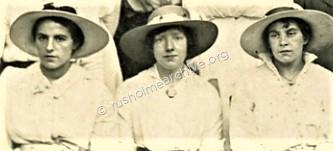
It might at this point look again at another quotation from Dr Susan Mumm:
“Rape, judging from penitentiary records, seems to have been an occupational hazard of service. Sisterhood reports mention the special problem of "girls who have fallen owing to violence."
That many young domestic servants were raped by their employers or by fellow servants cannot be doubted--the records at Clewer and other Houses of Mercy run by sisterhoods hold the proof. It is true that the word rape was never used at the time--the records tell us that this girl "was wronged," or that girl was "led astray," or another "was deceived."
You might at this point wonder what became of the poor little souls born in these circumstances. It was not until 1926 that legislation provided for formal adoption, in the absence of any regulation unwanted illegitimate children were sometimes taken in by family relatives or orphanages, at worse, some could end up with Baby Farmers. Unlike Manchester, London had a Foundling Hospital, established in 1739 by the philanthropic sea captain Thomas Coram. It was a children's home established for the education and maintenance of exposed and deserted young children.
In 2016 the Foundling Museum held an exhibition about ‘Fallen Women’. Although the specific circumstances were very different in Rusholme compared to the Foundling Hospital,a film based on the exhibition does give a very good insight about ‘The Fallen Woman’. You can view the film on Vimeo, if you follow the link, (depending on your browser you may need to scroll down the page a little to start the film) – click here
Returning to events that were revealed in the press, including Annual Reports, the following advertisement on April 1st, 1892 clearly was not for an April Fool.
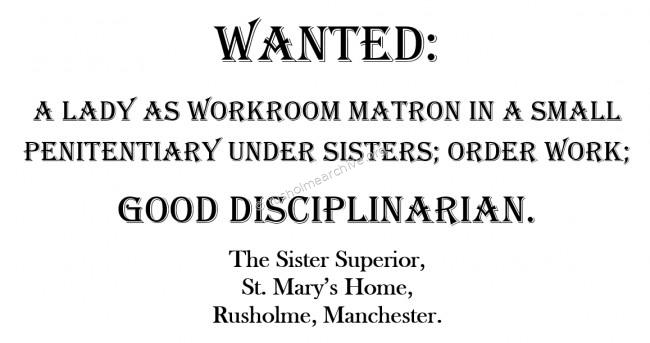
The consistent references in annual reports were about inadequate finance. Whilst the laundry clearly raised revenue, the home was still very dependent on contributions from a variety of Anglican church sources, but year after year a deficit was recorded.
However, in 1898 the financial situation must have changed as a decision was made to build an additional ward for some 20 inmates.
In April 1899, the Manchester Courier headed its report of the AGM: .
“The annual meeting of friends and supporters of this Protestant institution was held this afternoon at the Home, Dickenson Road the Lord Mayor presiding. Moving the Annual Report, he said,
“The Home, he believed, had been in existence for about, 30 years, commencing in a very small way and gradually year by year increasing in usefulness. He was pleased to hear that the additions made in the existing buildings would enable them to accommodate about twenty more inmates. Out of 36 women they had had in the Home 19 had been returned to their friends or to employment which had been found for them. The report showed that their finances were in an exceedingly satisfactory condition, and in this connection, he might say that he had rarely presided meetings of charitable institutions in Manchester during the last six months where there was not a deficit in the accounts. He was there to-day in his capacity of Lord Mayor, to do his best in urging the people of Manchester to support the Home to a still greater extent, and he thought it his duty to thank the sisters connected with the institution for the good work they had done during the past year.”
What is very strange in the newspaper report is the reference to the Home as a Protestant institution. As I had mentioned earlier Father Gethen of St Benedict, Ardwick had become Chaplain to St Marys in 1898 following the death of Rev Anson. Father Gethen of St Benedicts was probably the leading Anglo Catholic churchman in Manchester and over the years regularly clashed with the Diocesan hierarchy over the Catholic style of service. Perhaps the reference to protestant institute was from the owner of the Courier. Thomas Sowler was a strict Anglican and probably resented the appointment of Father Gethen as being too influential over the young inmates.
1901 Census: 4 Sisters of Mercy, headed by the Mother Superior, Sister Gertrude (Annie G. Roberts), 5 Matrons and 53 Inmates.
One issue that the Trustees had to unexpectedly to deal with at the beginning of the new century was the Factories Act. The members of the committee found it difficult to accept inspection of the Laundry by the Factory Inspector because in their view there were no employees. Perhaps they did not think that young women, perhaps in their early teens, working all day with boiling water, pressing machinery etc could be considered at risk? The authorities however prevailed and after the inspection by Major Wroe the trustees were relieved to know that the laundry was considered a safe place for the young inmates.
ST. MARY'S HOME, RUSHOLME.
1907. URGENT APPEAL FOR FUNDS. Bishop Welldon moving the adoption of the report and the balance-sheet, which showed an adverse balance of £549, said there was no reason to account adequately for the deficit except from the want of imagination.
‘If the Christian people of Manchester would only realise the magnitude the work which the home essayed to deal with, and the sympathy of the workers who dealt with it there would be no deficiency to face. The evil which called such a home as this into existence was not only — as was often called — a great sin, but it was the pathetic evil of the world. He alluded to the great temptations which girls were subjected to in those days, and to the persecution at the hands of men whose lack of honour and chivalry made them callous. He always held it was the duty of mothers to give their daughters warning against evils to which they might be exposed, for he had found great many cases where girls had fallen into evil because of ignorance. It was not difficult to remove ignorance.’
In conclusion he spoke of attempts to escape made by girls who had lost their character. This was the acme of tragedy. It was the privilege a home like St. Mary's to rescue from their erring ways.
Later that year, November 1907, a notice in the Manchester Courier referred to a
‘Grand Concert in aid of St Mary’s Home'.
‘Last night a grand concert in aid of St. Mary's Home, Rusholme, was held in the Rusholme Public Hall. Manchester. There was a good attendance, and an excellent programme was submitted, the artistes being Miss Nancy Dickenson, contralto; Mr. Seth Lancaster, cello; and the Haydn Concert Party, consisting of Messrs. A. Gresty, F. Morgan, and H. Morris. Mr. John Armitage, F.R.C.O., organist and director of the choir, St. Benedict s Church, Ardwick, was the accompanist.’
There was no reference as to the financial success…………..
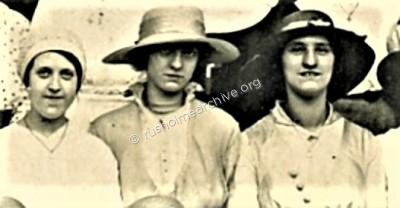
1911 Census; There was a total of 84 names registered in the Census returns of whom 4 were named as visitors. There were six Sisters of Mercy, led by 52-year-old Sister Annie Gertrude Roberts and identified as the ‘Superintendent’.
There were eight women with the title of Matron and the remaining names all marked as inmates with ages ranging from 13 to 30 and marked as single.
However, the details of one inmate particularly caught my attention. Edith Acheson was 42-year-old women who was the mother of two children and had been married for eighteen years. I wonder what circumstances had brought her to St Mary’s. Some sexual transgression, (adultery?), alcoholism, some other crime? I wonder if her family were standing by her – or were the children now in some institution?
1911: Rose Hyland Legacy
The trustees were presented with a problem regarding a legacy from a local philanthropist who, until her death, lived in Victoria Park. Mrs Rose Hyland was a wealthy widow who nowadays would probably be described as a feminist. However, in 1911 she was described as a strong supporter of ‘the woman’s cause’, notably as a significant activist for the suffragette movement.
At her funeral in St Edwards, Rusholme, Dr. Casartelli (Bishop of Salford) mentioned many aspects of her practical charitable work but specifically referred to her views on the injustice of our laws relating to sex matters, which the Bishop said, raised in Mrs. Hyland “a sense of fiery indignation.”
The trustees of St Mary’s were named as beneficiaries in the will of Rose Hyland but there was a problem to resolve. Mrs Hyland had inserted in a codicil to her will, a clause, applying to about fifty bequests, to the effect that if after the expiration of twelve calendar months from her death the secretary of the institution to which she gave the legacy had not two women on its committee, board, or managing body the legacy should be paid to the trustee of the Poor Prisoners' Defence Fund.
Predictably, (as might be expected at that time), St Mary’s Home was run by women, for the benefit of women, but was managed by an all-male committee. Anxious to receive the bequest, the trustees approached the Hyland Executors and proposed that if the two senior Sisters, Mother Superior Gertrude and Sister Superior Alice were appointed to the committee, would that satisfy the condition?
Although this did satisfy the requirements of the Will, I am not sure the spirit of Rose Hyland’s intention was met because looking through subsequent committee meeting there was no mention of the Sisters being present at the quarterly meetings.
1914 AGM
THE RECLAMATION OF GIRLS. MANCHESTER HOME'S GOOD WORK.
The Lord Mayor of Manchester (Alderman D. McCain) presided at the annual meeting yesterday of St. Mary's Home, Dickenson road, Rusholme. The home, which has for its object the helping of young girls, is the only one of the kinds in the Diocese of Manchester.
The annual report stated;
“It was often asked if they thought the work was justified, measuring it by the success of the girls in later life. The answer was most emphatically yes. On the whole, the results were extraordinarily good. Failures now and again they must expect.
Many of their girls were on the border line of feeble mindedness and had never known any discipline in their lives, and for such those the two years in the Home was hardly sufficient to build up character. Nor did they always remain full two years. One their difficulties came from the fact that parents sometimes removed the girls after a short time in the Home. They took them back to their old surroundings and their old bad companions with the result that the last state was often worse than the first. We are often asked if we think there is as much need for the Home now as when first started. It is difficult to estimate the moral conditions of society by year. In many ways there has been undoubtedly a great improvement in the general condition of society. People are more sober, better fed, better clothed, better housed, taking things all round. There has been a great advance in material prosperity, and possibly ln the spiritual life of the people as a whole. But while we note the outward signs of greater general respectability, we have to face many ugly facts and note many disquieting symptoms of modern life. The investigations of social workers, the records of the police courts, the life stories of the girls as they become known to us, are ample evidence to us of very terrible moral evil that lies just below the surface, and so escapes the notice of those who are not brought into actual contact with the lives of our people generally. And we know that it our resources permitted us we could multiply our work a hundred-fold and yet leave much undone. There is room for many more such ours in the Diocese Manchester.”
Early in 1915, a few months after the outbreak of WW1 the front page of the Annual Report had a very brief note referring to the 50th anniversary of the home originally being opened in Gorton. What should have been a year to celebrate a significant milestone began in a predictably sombre tone.
This year has brought the Jubilee of St. Mary’s Home but with the terrible War filling the lives and distracting the minds of practically all, it has been thought wiser to abandon any special external celebration.
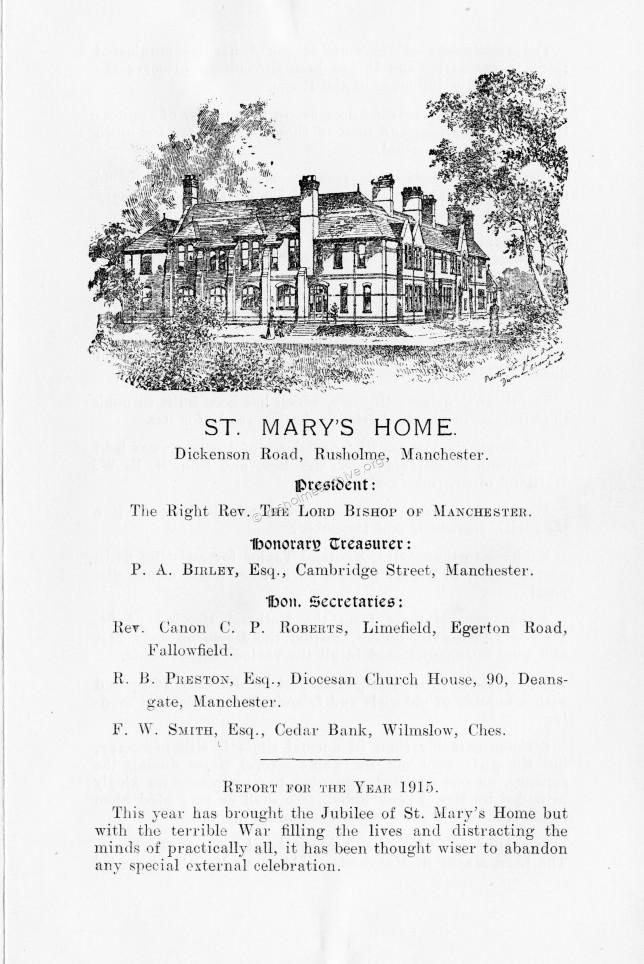
The image above is the front page of the report, below is the back page of the report, I should to thank the Chetham's Library for loaning a copy of the above Annual Report
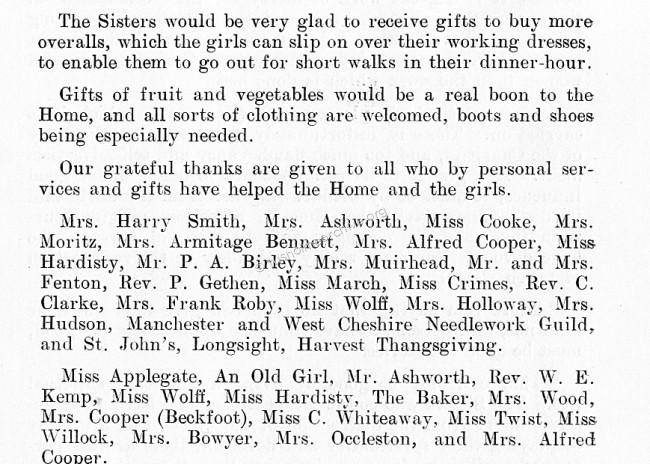
Inside the report once again the Bishop of Manchester referred to the difficult financial situation and said.
“It would be a pity if this institution were to have its work lessened through lack of support and the necessary funds for its continuance.
Work such as this deserves the support of the general public because it is a great work of mercy for the reclamation of those, who through foolishness and temptation, often strong temptation, have fallen.
If a girl is to be reclaimed and brought under good influence, it must be by withdrawing her from the world and its distractions, giving her time for reflection, religious surroundings, and the company and direction of persons who have devoted themselves wholly and solely to the reclamation of fallen sisters. The girls who have been here show how pleased they are with the care taken of them, they frequently come back to offer their thanks, and show their appreciation of what has been done for them.”
I am sure that during the course of the war the home faced many problems, the war must have brought many practical problems, but evidently there must have been a change in some aspect of how the home was functioning after I found the following report in a 1917 Burnley newspaper.
A 20-year-old Burnley girl, Annie Metcalfe), was brought before Accrington magistrates having been charged with breaking the terms of her probation for a previous offence of larceny._One of the conditions of her probation for the larceny was;
‘She should go for two and a half years to St Mary’s Home, Dickenson Road, Rusholme, Manchester.’
After a week she absconded and went back to Burnley. Her probation officer told the court that the prisoner promised to carry out the conditions of her probation, but she left the home and was evidently going from bad to worse. The accused told the magistrates that she left the home because she could not get on with the girls. Clearly the magistrates were not very sympathetic to Annie as she was sent to gaol for three months without hard labour.
Does this reference to the terms of probation indicate some informal(?) agreement between St Mary’s Home and the police/judicial authorities? Was there some view taken that compulsory attendance at the home would be of greater benefit rather than hitherto as a voluntary penitent?
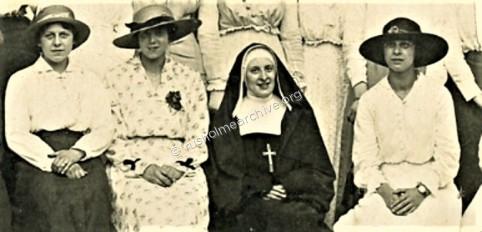
St Marys Home 1926 Report
Financial problems appear to be a major and continuing problem.
The report emphasises the lack of means to carry out all the technical training and general education which is necessary. The committee, it says, are faced with a choice of two things, to remain open and do the best they can though they know it to be inadequate and unsatisfactory or to close the Home. They believe "that they are choosing the lesser of the two evils, but they are frankly dissatisfied with "their enforced choice."
The Lord Mayor, who presided, spoke warmly of the work of the Home, remarking that it was of such a nature that it should have civic as well as personal recognition For that reason he had accepted the invitation of the secretary to take the chair.
There have been 73 girls in residence during the year. Much work has been done with the laundry attached to the Home, but the balance-sheet chows a deficit, of £173 instead of a credit of £388, as it did in January 1925. The most immediate need is for a motor-van for the collection and distribution of laundry.
1927 Report; The opening comments of the Annual Report specifically referred to St Mary’s as a training home.
The report stated that though the home had been in existence 61 years, questions were constantly being asked as to what it was and what work was being done there.
“It was a training home for 70 young girls, mostly between the ages of fourteen and twenty years, who for one reason or another had made a false start in life. Very frequently the girl herself was an innocent victim. It was the work of the home to try to obliterate the evil.
The girls when they left took good situations, and many married well and comfortably.”
Speaking about the work of the home The Bishop of Blackburn said,
“The difficulty of raising money to keep rescue work going was a general experience.
Some people who refused their help argued that such institutions were only tinkering with the problem of immorality, that they were not dealing with the real problem at all. They held that rescue work was expensive, and they were not sure that the results were commensurate with the amount spent on it.
How were the supporters of rescue work to meet that kind of attitude? There were few things more significant than the enormous strides which that work had taken during the last generation. There was perhaps no branch of social service that had been developed with a greater endeavour to make the new efforts on the right scientific and psychological lines. Up and down the country there was an enormous number of homes dealing with different sides of that great social problem. Along with that development had come recognition from authority in the shape of grants from the Ministry of Health.”
1928 Report; Canon How, Rector of Liverpool in an address on the need for such homes, said.
“That all present rejoiced in the larger freedom young people were experiencing in these days of emancipation, but it had its problems, and the moral welfare of young girls and women was among the big ones. _*To-day there was a greater need than ever for education in moral and sexual matters*. A great deal, more was being done in that direction in our schools, but it was not enough and not definite enough. Young people needed much clearer teaching and warning. They were running away with all kinds of wrong ideas about the teaching of modem day psychology and needed to be shown that the Christian discipline was still a vital necessity for a right and true kind of self-expression.”
1929 Report; Bishop of Manchester.
“He believed that rescue and preventive work was one of the most profitable things in the way of character-building being done in the Church to-day. He never used the words “fallen women."
He would be glad if they did not speak of preventive and rescue work, but always talked of ‘girls’ aid,’ and he would be glad if they could talk of ‘men’s aid’ in the same way.” He hoped the financial difficulty of the Home might in the long run be overcome by the voluntary help of those who cared for character-building, and who would bring hope, love and discipline to those who most sorely needed them, (Applause).
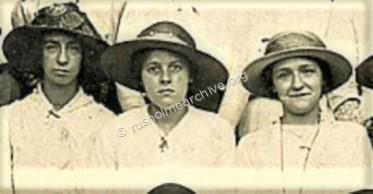
In 1931 the Annual Report referred to a new Anglican Order, the Community of St. Peter’s Chains.
Since 1889 St Mary’s Home had been managed by an Anglican Order from the House of Mercy at Horbury, near Wakefield in Yorkshire. In 1930 the new abbess at Horbury, Mother Sarah, introduced stricter rules for the convent: no-one could eat until after 12 noon and services were to be in Latin. The nuns at the Cathedral complained to the diocesan clergy and a disagreement between Sister Sarah and the Bishop over the provision of chaplains sparked Sarah's departure from Horbury with those nuns who supported her and they settled in London The remaining nuns were too few to maintain the Horbury House of Mercy which closed.
Consequently, in Rusholme, the Bishop of Manchester installed Sister Superior Gertrude as the first Reverend Mother of the Community of St Peters Chains. This new Order was to be responsible for managing St Mary’s for another decade.
The mission statement of the new order of St Peter’s was;
‘To live a life of entire self-sacrifice, manifested in rescue work among women and girls, in parochial mission work, retreat work and in such other ways as the community may deem consonant with the spirit of its foundation’.
If you consider the remarks made by the principal clerics in the 1927, 1928 and 1929 annual reports it does seem that earlier Victorian mores were less influential amongst younger people.
Another insight into the decline of religious influence amongst the population could be found only a few hundred yards away in a westerly direction along Dickenson Road. In 1862, (only 3 years before St Mary’s was established), a Wesleyan chapel was built that could hold a congregation in excess of 500. It was, apparently, very influential in the locality with a number of well-known worshippers. Yet the congregation had declined so much that it had closed in 1937 and the premises offered for sale.
1932 Annual Report.
Instead of having to rely on press reports, the Manchester Library Archives have an original copy of the 1932 Annual Report.
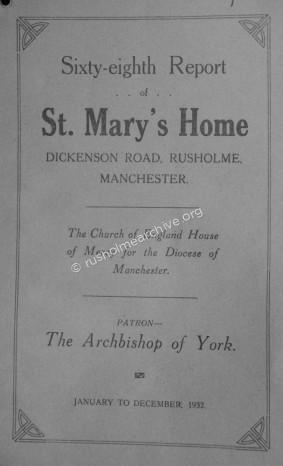
Cover of 1932 Annual Report courtesy of Manchester Archives; M629/3/6
It was quite interesting to read this full report rather than a report from a local paper. What seemed to be quite evident, (perhaps as referred to earlier in the various 1920’s reports) is a distinct change of emphasis from prayers and the drudgery of the laundry work to how valuable various aspects of recreation was in the training of the girls.
Perhaps predictably there was the usual self-congratulatory note about the success of training work: The one aim of the Home, under the loving and sympathetic supervision of the Sisters, is to wipe out the remembrance of the evil and to put in its place a lasting memory of a time spent in a happy and sure environment. The smiling faces of the girls at St. Mary’s are a sure indication that the Sisters are not failing in their work.
The next item that I noted was a reference about the shrinking income from the laundry,
“One of the many disastrous effects that the general depression has had upon the finances of the Home has been the reduction in work that has been sent to the Laundry. People have had to do their washing at home and the earnings from the Laundry have been correspondingly less. A very practical way of helping St. Mary’s is to send articles to the Laundry week by week, and we can assure you that the work will be well done.”
You can see I have emphasised in italics that the state of affairs was so bad people were having to do their own washing – presumably a reference to the middle-class supporters of the Home, (there must have been quite a few homes in Rusholme where working class women were taking in washing to keep their family fed).
CAMP. One of the great events of the year for the girls is the Annual Camp. This was again held at Rowarth, but alas, this year we could only have the accommodation for a little over a fortnight, and the girls can only go in batches. While at Camp, Miss Hudson, of Brabyn’s Hall, Marple, kindly entertained the girls by sending them to the pictures and giving them tea afterwards. Miss Hudson and her family were committed supporters of the Anglo Catholic Church and had been responsible for the building of a church near their home, Brabyn’s Hall. This would account for their relationship with St Mary’s Home. (Saint Martin's Church, Low Marple, is an Anglican church following the traditions of the Anglo-Catholic Oxford Movement. It was founded in 1867 by ancestors of Miss Hudson who, influenced by the Oxford Movement and the ritual revival in the Church of England, wished to establish a church where Anglo-Catholic ceremonial would be observed.)
RECREATION. All work and no play make Jill a dull girl as well as Jack a dull boy, and recreation plays an important part in the scheme of things at St. Mary’s. Some of the *Chorlton Rangers have again come forward and have taught drill and dancing to the girls, who have greatly appreciated their kindness. The Chorlton Rangers in addition gave the girls a tea and entertainment at the Home, and the Pendleton A Rangers invited twenty of the girls to a tea and entertainment in their own headquarters at Pendleton. The annual Christmas Party is always a very happy affair, and as usual a large number of old girls came to join in the fun. Some who were too far off to come wrote to say how sorry they were that they would have to miss it this year. Two friends paid for the girls to go to the Manchester Repertory Theatre at Rusholme, a great treat this, and on various occasions the girls have been taken to see suitable pictures. Many happy picnics have taken place, chiefly on Bank Holidays, and various activities have taken place among the girls themselves.
When I first saw the mention of *Chorlton Rangers I did some research to find out who they were – imagine my surprise searching local newspaper archives that the Chorlton Rangers were a rugby team. Now I am sure the young inmates would have welcomed rugby players to teach them dancing but after further research I found that in Chorlton the senior Girl Guides were known as 'Rangers'………
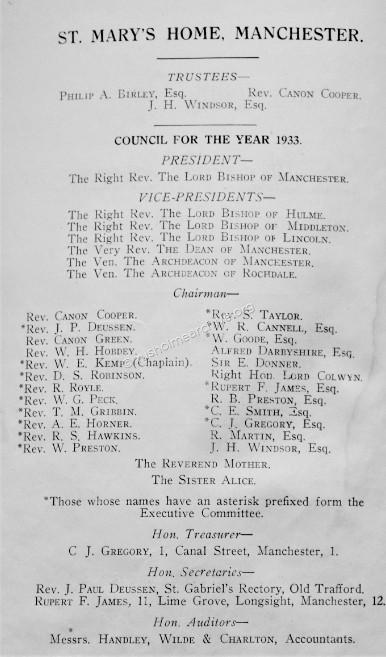
Image courtesy of Manchester Archives: M629/3/6
August 4th, 1937. Radio Appeal listed in the Manchester Guardian.

Only known photograph of St Mary’s Home below, courtesy of Manchester Archives: m38801
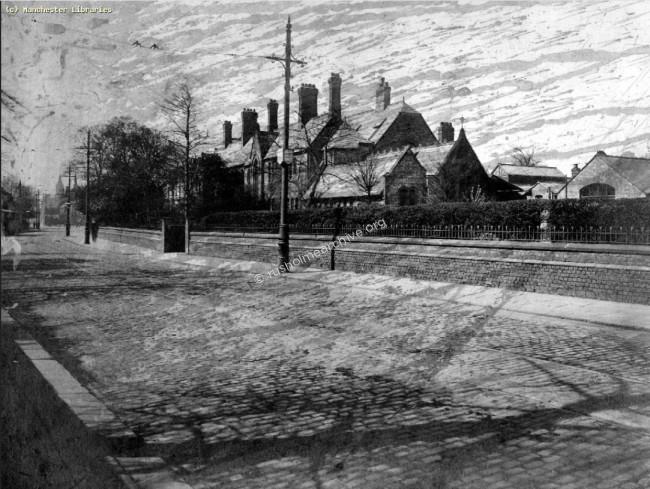
In the 1939 war register there were 7 Sisters of Mercy identified.
The first named was Sister Sarah, I presume she was the Mother Superior, having been elected a few months earlier, born in 1896 she was only 43 and one of the youngest. The second mentioned was *Sister Gertrude, she had served as Mother Superior since 1889, but presumably retired now that she was 81. There were two other comparatively young sisters, Sister Bessie who was 38, Sister Margorie(?) 43, but the other 3 Sisters were not youngsters, respectively 81, 66, 58, whilst the eldest lay member of staff was 84.
*Together with Sister Louise, (died April 1939), Sister Gertrude, (died May 1940), is buried in the graveyard at St James, Birch-in-Rusholme.
1940 Press report
The Guardian; MANCHESTER, ST. MARY’S HOME.
‘Notwithstanding the exceptional difficulties of the time, the council of St. Mary's Home, Dickenson Road, Manchester, reported yesterday at the annual meeting that a successful year’s work had been accomplished.
At the end of the year the deficit had been increased from £565 to £833, one of the contributory causes being the re-equipment and repair of the laundry, which had been in progress for three years and had cost altogether nearly £2,000. The laundry, however, was the home's principal source of income. Throughout the year the average number of girls in occupation of the home was 60.
Lady Robinson said that in this time of upheaval and emotional stress the work which the home was doing for girls was more likely than ever to be needed, and sacrifices should be made to support it’.
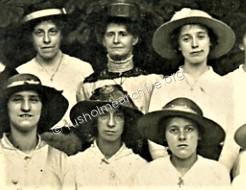
CLOSURE:
As I commented at the beginning of this paper, I am hoping that permission will be granted by the Diocese to see the minutes from 1939-1945.At the present time of writing these notes Covid rules are limiting access to archives. When the rules are relaxed I hope that the minutes may reveal the problems faced by the Trustees that led to the closure of St Mary’s in 1945. Some of the following notes are therefore speculation on my part and in due course I may have some firm information.
 In 1941 the Sisters of St Peters Chains must have come under pressure to review their stewardship of the home. The 1939 War Register did identify two younger sisters, but I wonder if the problems caused by the war, rationing, etc was too much for the older Sisters to manage the Home and inmates.
In 1941 the Sisters of St Peters Chains must have come under pressure to review their stewardship of the home. The 1939 War Register did identify two younger sisters, but I wonder if the problems caused by the war, rationing, etc was too much for the older Sisters to manage the Home and inmates.
According to Peter Anson, in his history of Anglican Community Orders, ‘The Call of the Cloister’, the Order of St. Peters Chains, based at St Mary’s Home was replaced by Sisters from the Community of St Mary the Virgin (CSMV). This order based at Wantage in Oxford was invited by the Manchester Diocese to manage St. Mary’s. Their stewardship was for just over three years, during this time the Home Office licenced St. Mary’s to be an ‘Approved Home’ but the certification ended within a year.
I imagine that a number of concerns about the Home, particularly its physical condition, (see the item below about its purchase by the City Council), together with the perennial problem of finance led to the Diocese closing the Home.
Another factor that I think may have played a part is the changing of sexual mores within society at large. Attitudes of the Clergy and their circle clearly became less influential between the two world wars and by WW11 ‘sex outside of marriage’ was not viewed in the same context as it had been at the time St. Mary’s was opened in 1864.
At least eleven ‘Homes for Unmarried Mothers’ had been established in Manchester between 1890 and 1926, were they some form of competition? and perhaps young women, once regarded as ‘fallen’ may have chosen this option?
Another possible factor is that after WW1, service as it had been known during the Victorian era faded away. Training young women for a career in household service and laundry must have had limited appeal with poor pay and employment prospects.
The final closure of St Mary’s Home was in June 1945, this decision coinciding with Manchester Education Committee searching for a residential property that could accommodate 40 children.
During WW2 children in the care of Manchester Education Committee were moved to Lytham St Anne’s, a sea-side location that considered safe from enemy bombing. After the war the children, described as “handicapped (sub-normal),” and needing residential care, were to be taught at a special school at Cheetham Hill.
The Education Committee was aware that St Mary’s Home was in the process of closing and arranged to view the premises. Council officers inspected the property and although aware the trustees were planning to lease the building the Council made an offer to buy St Mary’s. They had found the building in very poor condition and decided that rather refurbishing the home as tenants it would be better value to offer £1500.00 for the one-and-a-half-acre site and £1000.00 for the building.
By September 1945 negotiations were concluded by the District Valuer and the total price paid was £3000.00. The Education committee also agreed to buy the contents, (furniture, bedding and crockery etc. for £800.00 and then made provision for a further £1,400.00 to refurbish the property.
Following the completion of the works the former St Mary’s Home was re-named Ribble Lodge and
used as a mixed home catering for both boys and girls. The home provided a stable environment where children who were having difficulties at home could either stay at permanently or occasionally and continue to attend Cheetham Special School. The records for Ribble Lodge show that it closed in 1956.
When I examined the Education Committee minutes there was no mention of the laundry that had been an integral part of St Mary’s Home. As the laundry was housed in a separate building, I think the building may have been leased separately.
In October 1945, an edition of the Manchester Evening News posted an advertisement by the Premier Laundry Company who were seeking a ‘strong woman’ to work in the washhouse at 77 Dickenson Road.
On January 20th 1958, the Manchester Guardian reported that 77 Dickenson Road would now be the Cardinal Mindzenty Club.
"With a toast in Tokay and a cry of “Long live Hungary,” Alderman L. Lever, M.P, Lord Mayor of Manchester, on Saturday opened what is claimed to be Britain’s first comprehensive club for Hungarians outside London. It is the Cardinal Mindszenty Club, which has been established by a committee of exiles in premises rented from the Manchester Education Committee at 77 Dickenson Road, Manchester, and the opening ceremony attracted Hungarians from many parts of the North of England.
So far, the club has about two hundred members, drawn mainly from the settled Hungarian community in the North-west but including visitors from Yorkshire and the Midlands and some of the refugees who are still at Styal Cottage Homes, awaiting permission to enter Canada or the United States. It contains a restaurant, a bar, and several public rooms, one of which was turned into a concert hall on Saturday so that members could entertain themselves and their British guests.
It is also, in the words of Mr F. H. Johnson, Manchester corporation officer for refugees, “a Hungarian Y.M.C.A.,” offering residential accommodation for 40 single men and sports facilities which may well be envied by many a British club in the city. The coaches already include a fencer and a boxer who have been members of Hungarian Olympic teams. On three nights a week, too, it will provide an information centre for the refugees, staffed by the Women's Voluntary Service, the Citizens' Advice Bureaus, and other bodies.
Alderman Lever said on Saturday that although the members of the club refer to themselves as exiles, he hoped they would soon come to feel at home in Manchester, a city which had known what it was to fight against oppression and had watched their stand with admiration.
The founders of the club feel that it will play an important part in helping the refugees to settle in this way and they hope that British people will become associate members and enjoy the facilities it offers as well as the opportunities it will give for mixing with Hungarians.”
In the absence of access to the Education Committee minutes and any press reports I have not been able to find any information about how long the Hungarian Club remained at 77 Dickenson Road, but I think by 1963 the St Mary’s Home premises had been demolished, (and even then the laundry building may have remained for a further year or two?)
So although St Mary’s was demolished some 50+ years ago, I have managed to find one resident who lived nearby in Wallace Avenue and who could recall the Home.
Mr Johnson, (90+), died recently but could just remember as a child the young women from the home;
‘Rum looking lot’ he said, ‘They used to take them in a long line each day for exercise to the park. They used to be dressed in raincoats and wellingtons.’
On the premise that the last ‘inmates’ were there in 1944, I do wonder if there are any living survivors? They would of course now be in their 90’s but it would be very interesting if they could recall their time at the Home.
"On a personal note I must be candid and say that to me St Mary’s Home as an institution was a way of life that is quite unimaginable today. Young ‘unchaste’ women were labelled by clerics as guilty of moral impropriety. But those clerics and their circle failed to recognise that in reality many of the young women were poor, vulnerable, and too often victims of sexual abuse. Certainly, during the first 50 years of St Mary's Home the young inmates endured at least two years of drudgery and prayers and then, no longer ‘fallen’ but respectable, they were returned to poorly paid service.
In fairness to the work of the nuns, many of the young women who were admitted to St Mary’s found a safe refuge when the only alternative was at best, the Workhouse. I am sure the work of the nuns and their lay assistants in the Home must have given the young women a level of discipline that was new to them but perhaps that was a minor inconvenience compared to an assured bed, food and shelter.
In closing you may it find it interesting to note that in the last two or three years of its life St Mary’s Home was once again a refuge, but this time for the men and women who had fled the Hungarian uprising".
In preparing this page I should like to thank Sarah Hobbs, Archives Officer and her colleagues at the Manchester Library Archives, Dr Susan Mumm, Principal, Brescia University College, Sister Robina of Horbury, and the late Michael Powell of Chetham’s Library.
